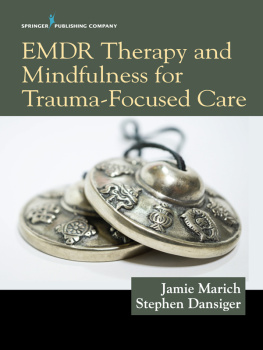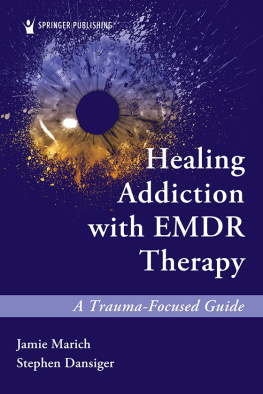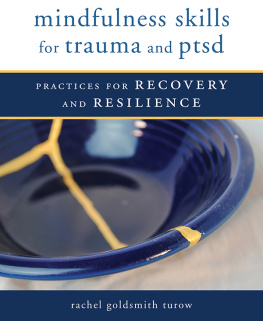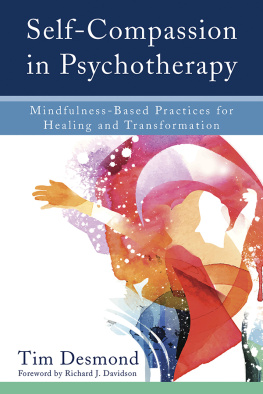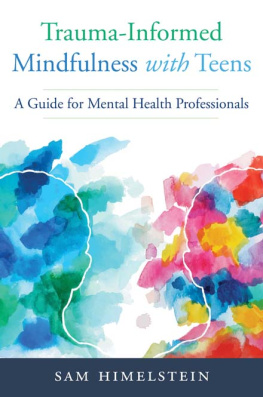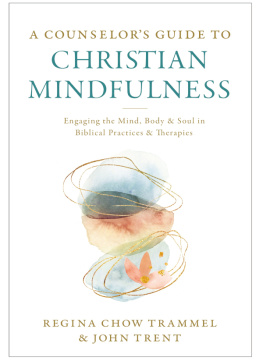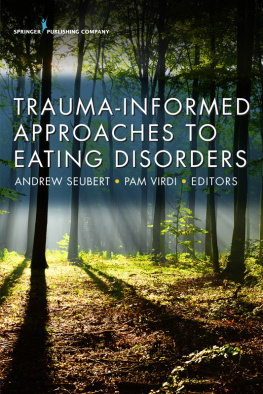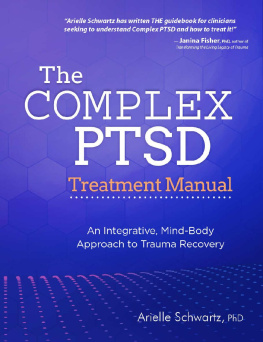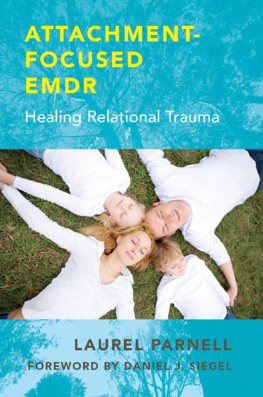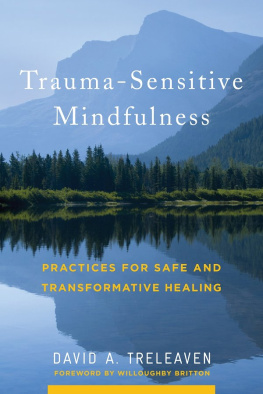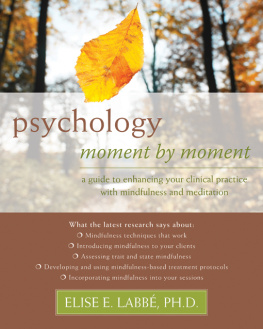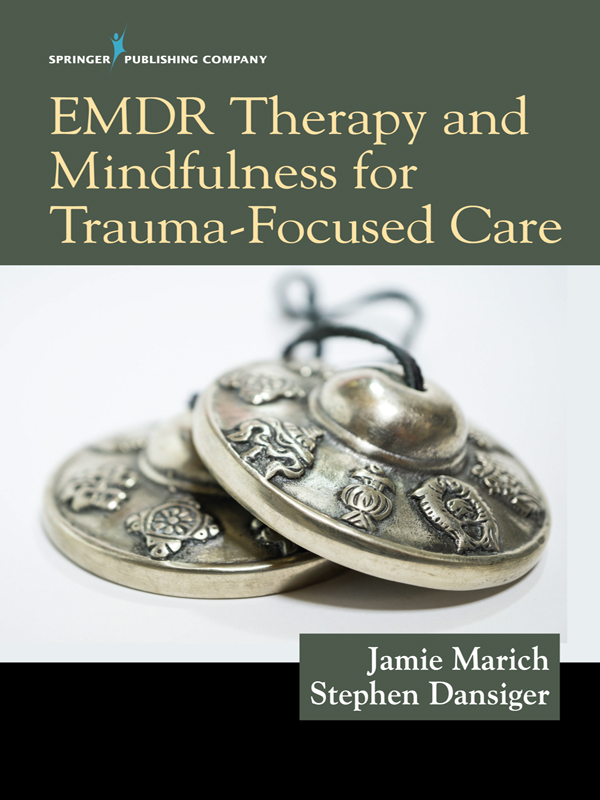Contents
Guide
i EMDR THERAPY AND MINDFULNESS FOR TRAUMA-FOCUSED CARE
ii ABOUT THE AUTHORS
Jamie Marich, PhD, LPCC-S, LICDC-CS, REAT, RMT, travels internationally to teach on eye movement desensitization and reprocessing (EMDR) therapy, trauma, addiction, expressive arts therapy, and mindfulness while maintaining a private practice in Warren, Ohio. Dr. Marich is the author of EMDR Made Simple: 4 Approaches for Using EMDR With Every Client (2011), Trauma and the Twelve Steps: A Complete Guide to Enhancing Recovery (2012), Trauma Made Simple: Competencies in Assessment, Treatment, and Working With Survivors (2014), and Dancing Mindfulness: A Creative Path to Healing and Transformation (2015). She is the founder of the Dancing Mindfulness practice and expressive-arts community and actively offers EMDR therapy training through her company, Mindful Ohio & The Institute for Creative Mindfulness. Marich began her career in human services as a civilian humanitarian aid worker in Bosnia-Herzegovina (20002003). Her award-winning dissertation research on the use of EMDR therapy in the treatment of addiction was published in two APA journals (Psychology of Addictive Behaviors and Journal of Humanistic Psychology). In 2015 she received the NALGAP Presidents Award for her work as an LGBT advocate.
Stephen Dansiger, PsyD, MFT, is clinical director of Refuge Recovery Centers in Los Angeles, a cutting-edge addictions treatment center where he developed and implemented the MET(T)A Method (Mindfulness and EMDR Treatment Template for Addictions). The treatment utilizes Buddhist psychology and EMDR therapy as the theoretical orientation and primary clinical practice. He is an EMDRIA Approved Consultant and Certified Therapist, and provides EMDR Basic Training and workshops through Mindful Ohio & The Institute for Creative Mindfulness. He is the author of Clinical Dharma: A Path for Healers and Helpers (2016) and avidly blogs and podcasts on topics related to mental health, recovery, and mindfulness. Besides maintaining a private practice in Los Angeles, he travels nationally and internationally, speaking and teaching on Buddhist mindfulness, EMDR therapy, the MET(T)A Method, trauma, the Refuge Recovery treatment model, and clinician self-care. He has been practicing Buddhist mindfulness for almost 30 years (including a one-year residency at a Zen monastery), and teaches dharma classes regularly at Against the Stream Buddhist Meditation Society in Los Angeles and at other centers nationally and internationally.
iii EMDR THERAPY AND MINDFULNESS FOR TRAUMA-FOCUSED CARE
JAMIE MARICH, PhD, LPCC-S, LICDC-CS, REAT, RMT
STEPHEN DANSIGER, PsyD, MFT

iv Copyright 2018 Springer Publishing Company, LLC
All rights reserved.
No part of this publication may be reproduced, stored in a retrieval system, or transmitted in any form or by any means, electronic, mechanical, photocopying, recording, or otherwise, without the prior permission of Springer Publishing Company, LLC, or authorization through payment of the appropriate fees to the Copyright Clearance Center, Inc., 222 Rosewood Drive, Danvers, MA 01923, 978-750-8400, fax 978-646-8600, .
Springer Publishing Company, LLC
11 West 42nd Street
New York, NY 10036
www.springerpub.com
Acquisitions Editor: Sheri W. Sussman
Compositor: S4Carlisle Publishing Services
ISBN: 978-0-8261-4914-5
ebook ISBN: 978-0-8261-4915-2
Downloadable Worksheets are available to all readers at springerpub.com/marich
Worksheets ISBN: 978-0-8261-4909-1
17 18 19 20 21 / 5 4 3 2 1
The author and the publisher of this work have made every effort to use sources believed to be reliable to provide information that is accurate and compatible with the standards generally accepted at the time of publication. The author and publisher shall not be liable for any special, consequential, or exemplary damages resulting, in whole or in part, from the readers use of, or reliance on, the information contained in this book. The publisher has no responsibility for the persistence or accuracy of URLs for external or third-party internet websites referred to in this publication and does not guarantee that any content on such websites is, or will remain, accurate or appropriate.
Library of Congress Cataloging-in-Publication Data
Names: Marich, Jamie, author. | Dansiger, Stephen, author.
Title: EMDR therapy and mindfulness for trauma-focused care / Jamie Marich and Stephen Dansiger.
Description: New York : Springer Publishing Company, [2018] | Includes bibliographical references and index.
Identifiers: LCCN 2017037535| ISBN 9780826149145 | ISBN 9780826149152 (e-book)
Subjects: | MESH: Stress Disorders, Traumatic--therapy | Eye Movement Desensitization Reprocessing--methods | Mindfulness--methods
Classification: LCC RC489.E98 | NLM WM 172.5 | DDC 616.85/210651--dc23 LC record available at https://lccn.loc.gov/2017037535
Contact us to receive discount rates on bulk purchases.
We can also customize our books to meet your needs.
For more information please contact:
Printed in the United States of America.
v With love and gratitude to Joe Long (19802016), my friend and my coach. You left us much too young and I will do my best, dear buddy, to continue writing from our shared mission of authenticity. Thanks for being my spiritual bouncer in this process!
Jamie
With love and a deep bow to Maggie Estep (19632014). Thank you for helping me find my recovery, and then renewing my first-ever bilateral toolkit, my drumming. Every day that I help others stems directly from your reaching out all those years ago. And to Sadie, who keeps me in a steady gait toward true north... and to all the other Buddhas and Bodhisattvas I have met along the way.
Steve vi
vii Contents
by Noah Levine, MA
viii
ix
x
xi
xii
xiii List of Meditation Practices and Experiential Exercises
xiv
xv Foreword
EMDR therapy is the Dharma. Dharma means to see clearly and respond wisely. The Buddha often said that he only taught the truth of suffering and how to end suffering. Buddhism teaches many different techniques in the service of ending suffering, mindfulness being the main meditative technique offered in the core teachings, called the Eightfold Path.
EMDR therapy is mindfulness. Mindfulness is the Dharma.
When I learned that the core philosophy of EMDR is about bringing mindfulness to the held memories and sensations of our past traumas, while practicing bilateral attention, I realized that for the last 30 years, one of the primary practices I have been engaging in as part of my Buddhist training is walking mindfulness meditation. While walking slowly, bringing attention bilaterally, left-right, left-right to the sensations of each footstep. In the silence of retreat the mind often releasing the pain of the past. As I noted, right-left, right left. I believe that much of my early life suffering and trauma was reprocessed and integrated as the mindfulness of what was arising and passing was noted and eventually met with compassion and forgiveness.
When I told my father, Stephen Levine, about being trained in EMDR, he told me that Francine Shapiro had been his student around the time she had created EMDR and that much of it may have come from the mindfulness he was guiding her in as a way to be with grief.
Next page
